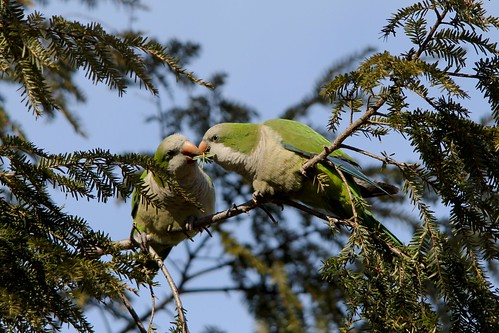 Brooklyn Parrots. Image by Jeremy SetoNEW YORK -- Alex Joseph, a West Indian-born parks worker, rakes the lawn at the grandly gothic Greenwood Cemetery in Brooklyn when he and his fellow laborers hear what sounds like a flock of sea gulls dive-bombing at their heads. The workers instinctively duck and whip round and look up and see -- those crazy green parrots, expertly mimicking the sea gull's caw.
Brooklyn Parrots. Image by Jeremy SetoNEW YORK -- Alex Joseph, a West Indian-born parks worker, rakes the lawn at the grandly gothic Greenwood Cemetery in Brooklyn when he and his fellow laborers hear what sounds like a flock of sea gulls dive-bombing at their heads. The workers instinctively duck and whip round and look up and see -- those crazy green parrots, expertly mimicking the sea gull's caw.
"Man, they do that a couple times a week just to play with our minds," Joseph said, grinning wide and shaking his head. "They are a crazy bunch of immigrants, those birds."
They are the wild parrots of Brooklyn, these emerald-feathered yakkers with the wisenheimer sense of humor. Thought to be long-ago escapees from a container at John F. Kennedy International Airport, their ranks replenished by unauthorized releases from pet shops, the parakeets -- originally from Argentina -- have become accomplished city dwellers. There is a parrot colony along the Hudson River cliffs in New Jersey and another bunch that prefers Pelham Bay Park in the Bronx. Of late, two arrivistes have taken up residency on an apartment ledge on the Upper West Side of Manhattan.
"They are successful Brooklynites, in that they are adaptable, eat a wide variety of foods and like to talk," says Eleanor Miele, a professor at Brooklyn College who lives in the Park Slope neighborhood and has found herself entranced by the parrots.
New York has many wild critters, and a few are not human. A coyote wandered into Central Park before running afoul of sunbathers, and the hawks Pale Male and Lola established aeries on a gilded stretch of Fifth Avenue. Raccoons know their way around Brooklyn's Prospect Park, and muskrats poke at the mud flats of the Harlem River.
But the parrots -- which are about a foot long and are known as monk parakeets because their gray chests and tufts resemble a monk's skullcap and frock -- are among the city's more cacophonous and unexpected residents. Their cry sounds like metal scraping metal. (San Francisco has parrots-in-residence on Telegraph Hill. And Chicago has a broad-shouldered, loud-squawking crew that has been called "Hells Angels with wings.")
Con Edison knows these nests well, as periodically the power company's workers clamber around them. "These aren't nests; they're condominiums," a spokesman said.
Half a dozen nests can be seen atop the light poles at the Brooklyn College athletic field. On a recent Saturday, 20 or 30 of the resident parrots swooped down and, amid much screeching, alighted on the branches of an oak tree beside a pre-World War II apartment building. Children inside the apartments gestured and called at the birds; sometimes the parrots talk back. (In captivity, monk parakeets can develop a vocabulary of about 200 words.)
Steve Baldwin, 50, lives in Bay Ridge in Brooklyn and acts as the parrots' pro bono publicist and bard. He has composed a Lou Reed-style song, "The Ballad of the Brooklyn Parrots" (available at BrooklynParrots.com), which mixes human and parrot voices and which one "critic" called "Jim Morrison meets Rick Moranis at the Audubon Society."
"They eat berries, ornamental plants and sometimes pizza," Baldwin said as he gave a tour of the Brooklyn College nests to a dozen birders. "They are very intelligent, and of course they don't like the suburbs."
How the parrots came to Brooklyn is a mystery. Apparently a large crate filled with the parrots broke open at Kennedy International Airport in the late 1960s. Baldwin's voluminous research tends to implicate mafia goodfellas in the deed, although that "fact" might be too delicious to check out. The parrots hung around the Jamaica Bay marshes that girdle JFK's southern edges before moving into Brooklyn. The cold was no problem, as the parrots hailed from temperate-to-chilly Argentina.
At first, state and federal wildlife-control officers tried to wipe out this "invasive species." Hundreds of parrots perished, and in the 1970s, the last large colony relocated to light towers at the Rikers Island jail. An eradication team showed up to finish the job -- but the parrots had disappeared.
"Someone tipped the parrots off," Baldwin says with a shrug. "They circled back to Brooklyn, and everyone left them alone."
Now there is a new threat. Poachers with nets are snatching the parrots and selling them to pet stores. The poachers have all but denuded several neighborhoods. It has parrot-loving denizens of Brooklyn talking about vigilante patrols.
Kay Martin lives somewhere near Coney Island, in a house filled with at least nine varieties of parrots. She acknowledges that their racket awakens her at night. So what? They are friends, and they talk to her. Martin, diminutive and pugnacious, spends most of her spare time safeguarding the wild parrots.
Are there nests near your home? She frowns.
"I'm not saying," she says. "The last thing our parrots need is another reporter poking around."